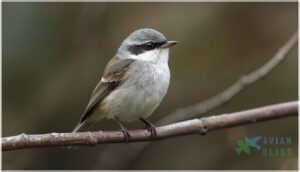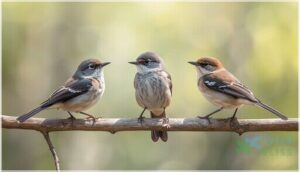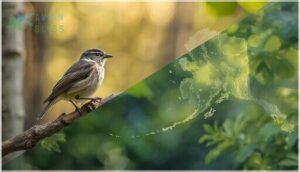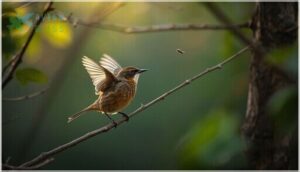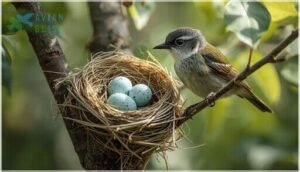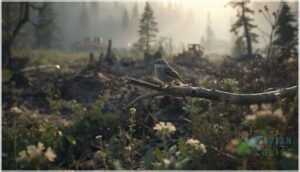This site is supported by our readers. We may earn a commission, at no cost to you, if you purchase through links.
You might walk past a least flycatcher a dozen times without noticing—its grayish-olive back blends seamlessly into the dappled light of northern hardwood forests. But this unassuming songbird, barely longer than your palm at 12 to 14 centimeters, has lost more than half its population in the past five decades.
The decline isn’t just numbers on a chart. It’s a warning sign written across landscapes where fragments of forest replace the continuous canopy these birds need to thrive. Understanding how to identify this species and recognize its ecological needs becomes more urgent as habitat loss and climate change reshape North American bird communities.
Recognition starts with that bold white eyering and the bird’s preference for sit-and-wait hunting—small details that separate the least flycatcher from its look-alike cousins.
Table Of Contents
- Key Takeaways
- Least Flycatcher Identification
- Range, Habitat, and Migration
- Behavior and Diet
- Nesting and Breeding Habits
- Conservation Status and Threats
- Frequently Asked Questions (FAQs)
- What is the least of Flycatchers?
- Where do least flycatchers live?
- What sound does a Least Flycatcher make?
- What is the difference between yellow bellied flycatchers and least flycatchers?
- How does climate change affect Least Flycatchers?
- What are the migration challenges for Least Flycatchers?
- How do Least Flycatchers interact with other bird species?
- What are the primary threats to their nesting sites?
- How do Least Flycatchers adapt to urban environments?
- How long do Least Flycatchers typically live?
- Conclusion
Key Takeaways
- The least flycatcher has lost more than half its population since 1970—a 53% decline driven by habitat fragmentation, climate shifts that push migration timing two weeks earlier, and vanishing forest corridors that once connected breeding and wintering grounds.
- You’ll identify this gray-olive bird by its bold white eyering, sharp “che-bec” call fired 60 times per minute, and sit-and-wait hunting style from mid-canopy perches where 81% of prey capture involves hovering rather than typical hawking flights.
- These flycatchers pack breeding territories into dense neighborhoods of 2–30 pairs per cluster, aggressively defending trembling aspen groves with 98% canopy cover—a social strategy that creates hidden lek structures where dominant males secure extra-pair matings.
- Conservation demands landscape-scale action: protecting unfragmented forest blocks over 50 meters from agricultural edges, restoring understory through deer management, and maintaining connectivity across 3,000-kilometer migration routes before climate models predict 22% range contraction by 2050.
Least Flycatcher Identification
You might think all small, gray-brown birds look alike, but the Least Flycatcher has a few telltale signs that set it apart.
Once you know what to look for, this diminutive flycatcher becomes surprisingly easy to pick out from the crowd.
Here’s what makes this bird distinctive in the field.
Physical Characteristics
You’ll spot the Least Flycatcher’s compact frame—just 12 to 14 centimeters long—wrapped in grayish-olive plumage patterns above and whitish below. Your eye catches that proportionally large, rounded head structure right away. Notice the short, triangular beak shape with its pale lower mandible.
Those feather colors stay pretty uniform: no dramatic contrasts, just clean lines. Two white wingbars and a bold eyering frame the face, setting these Empidonax flycatchers apart from their look-alikes.
The species’ identification relies on understanding its bird conservation status.
Distinctive Features
Beyond those basics, you’ll use plumage patterns to nail Least Flycatcher identification among Empidonax flycatchers. That bold eyering and sharp wingbars create high-contrast field marks you can trust. Color contrasts matter too—watch for the whitish throat against gray-olive upperparts. Tail features stay square-tipped, and vocal signatures clinch it: the emphatic “fitz-bew” song separates this species instantly when flycatcher characteristics overlap visually.
Understanding the bird’s true songbirds characteristics is essential for accurate identification.
Similar Species Comparison
You’ll face real identification challenges when separating Least from other Empidonax flycatchers—especially Alder and Willow. Morphometric studies show these species overlap considerably, with Least misidentified up to 22% on plumage alone.
Hammond’s Flycatcher sports longer wings (68.3 mm versus Least’s 62.7 mm), while Alder’s rounder body creates confusion. Primary projection under 12.5 mm helps confirm Least, but habitat context improves your accuracy another 12–18%.
Identification Tips
When Least Flycatchers aren’t singing, rely on voice above all else. That piercing “che-bec” cuts through dense foliage where plumage details vanish. In spring, fresh eye rings and wingbars pop against gray-olive backs—your best visual window before summer wear dulls the contrast and migration timing shifts age ratios in the field.
- Listen first: The sharp two-syllable call outperforms plumage patterns for species identification in overlapping ranges
- Check the eye ring: Look for that bold, complete white circle—rounder and brisker than most congeners
- Measure primary projection: Under 12.5 mm separates Least from longer-winged Hammond’s and Alder flycatchers
- Note the season: Fresh spring adults show clearer facial markings and tail features than worn late-summer juveniles
Range, Habitat, and Migration
The Least Flycatcher spans an impressive stretch of North America, from Alaska’s boreal edges to the woodlands of Newfoundland. This small gray bird knows how to read the seasons, shifting between northern breeding territories and tropical wintering grounds with precise timing.
Understanding where you’ll find this species—and when—reveals the rhythm of its life across the continent.
Breeding and Wintering Grounds
You’ll find this tiny acrobat nesting from southern Yukon to the Maritime Provinces, pushing south to Wyoming and New Jersey’s mountains. Come winter, it chases warmth through Mexico and Panama, trading northern hardwood forests for tropical edges below 3,200 feet. That 3,000-kilometer journey connects boreal breeding grounds with Central American retreats—a twice-yearly odyssey compressed into nature’s tightest schedule.
| Season | Geographic Range | Elevation |
|---|---|---|
| Breeding | Yukon to North Carolina | Variable |
| Wintering | Mexico to Panama | Below 975–1,525 m |
| Migration Routes | Continental flyways | Multiple zones |
| Breeding Patterns | 63% Wisconsin atlas coverage | Northern forests |
| Wintering Sites | Pacific/Caribbean slopes | Tropical edges |
Habitat Preferences
You’ll spot these flycatchers claiming territory in open woods where trembling aspen dominates—75% of nests wedge into those very trees. They’re picky about forest structure and deciduous composition, thriving where canopy cover hits 98% and mature trees create dense overhead shelter. Habitat fragmentation pushes them deeper into interiors, away from expanding clearings.
Key deciduous woodlands features they favor:
- Trembling aspen and balsam poplar for nesting sites
- Canopy heights averaging 12.47 meters with dense cover
- Minimal shrub layer (8%) but lush ground vegetation (95%)
- Basal area of 29.22 m²/hectare indicating mature stands
- Territory spacing of 0.18 acres in high-quality habitat
Migration Patterns
During migration to Central America, these flycatchers travel 60–72 miles daily over 25 days. Adult migration timing has shifted dramatically—median departure moved up 14 days since the early 1990s, accelerating at 4.5 days per decade due to climate shifts. Adults now leave by August 1, while hatch-year birds lag two weeks behind.
This age-based timing split reveals population dynamics responding unevenly to warming trends.
Key Stopover Sites
You’ll find Least Flycatchers refueling in surprising places during their bird migration patterns. Great Lakes coastal wetlands and Gulf Coast forests serve as essential habitat zones before and after trans-Gulf crossings.
Don’t overlook forest fragments and urban stopovers—these migrants exploit small woodland patches in developed landscapes, concentrating where artificial light meets remaining cover.
Conservation status concerns mount as coastal development shrinks these critical refueling networks.
Behavior and Diet
The Least Flycatcher is a master of efficiency in catching its meals. You’ll notice this bird uses a classic sit-and-wait strategy, launching quick aerial attacks from its favorite perches.
Understanding how it hunts, what it eats, and how it interacts with other birds gives you the full picture of this small flycatcher’s daily life.
Foraging Techniques
You’ll find the Least Flycatcher employing a classic sit-and-wait strategy that defines insectivores like it. Perch selection focuses on exposed dead twigs in mid-to-lower canopy, where aerial hunting begins.
Remarkably, 81% of prey detection and insect capture involves hovering—not the hawking you’d expect from a flycatcher. This bird pivots on its perch for 360-degree views, then launches short sallies for efficient feeding behavior targeting flying insects.
Primary Food Sources
Lepidoptera and Orthoptera dominate your field observations—these two groups alone exceed 50% of diet composition in nestlings. Small wasps, winged ants, beetles, and caterpillars round out this insect diet, with true bugs and grasshoppers appearing seasonally. Spiders contribute less than 10% to food webs.
Occasionally you’ll document blackberries or elderberry consumption, but insectivores like this flycatcher rely overwhelmingly on insect prey for feeding behavior.
Social and Territorial Behavior
Territorial Clustering sets Least Flycatcher behavior apart—you’ll find breeding territories packed into dense neighborhoods with 2–30 adjacent pairs, reaching 3.6 territories per hectare.
Aggressive Behavior defines these clusters: birds chase American Redstarts, cowbirds, even Blue Jays twice their mass.
Social Dominance peaks in central territories, where males access extra-pair matings. This hidden lek structure shapes Mate Selection and Breeding Strategies across populations.
Vocalizations and Communication
Beyond physical aggression, you’ll recognize these flycatchers through their signature “che-bec” song—a sharp, two-note acoustic signal that defines territorial defense. Males fire off 60 notes per minute on hot summer days, establishing boundaries through vocal learning and call types that vary by context:
- Sharp “pwhit” flight calls coordinate movement
- Alarm calls deter predators from nests
- Dawn choruses peak during breeding season
- Regional song dialects emerge across populations
- Buzzes and trills aid in mate attraction
This vocal repertoire separates them from look-alike Empidonax species.
Nesting and Breeding Habits
Least Flycatchers don’t just show up and build anywhere—they’re strategic about where they raise their young. From choosing the perfect fork in a sapling to weaving a nest bound with spider silk, these small birds follow precise patterns that boost their chances of success.
Let’s break down how they select sites, construct their nests, manage eggs, and guide their offspring to independence.
Nest Site Selection
You’ll find Least Flycatchers choosing nest sites with exceptional precision. They select trembling aspen and balsam poplar trees about 3.6 meters high, favoring branch forks near the trunk.
Habitat preferences include 98% canopy cover and moderate understory openness. Microhabitat preferences emphasize larger trunk diameters and ample ground cover.
These nesting habits reflect their need for protection—placing nests where leaf cover reduces predation while maintaining structural support.
Nest Construction and Materials
Once the female selects her site, she works alone for five days, weaving a compact cup just 2.5 inches across. You’ll see her construction techniques blend:
- Bark strips and grasses form the foundation
- Spiderwebs and caterpillar silk bind everything tight
- Animal hair and feathers line the interior
This bird engineering creates extraordinary nest durability—water-resistant architecture that withstands weather while protecting her young.
Egg-Laying and Incubation
After nest construction wraps up, you’ll witness the female laying one egg daily until her clutch of usually four eggs is complete—though two to six eggs can occur. She alone manages the 14-to-16-day incubation period, maintaining a precise temperature around 99.5°F.
With nest success rates reaching 79% in prime habitat, these determined birds show impressive hatching rates when predation and parasitism stay low.
Parenting and Fledging
Once the young hatch, both parents share nestling care, delivering food 4–7 times hourly during peak feeding. Nest attendance exceeds 80% until fledging at 12–14 days.
Most broods contain four fledglings, and brood survival regularly tops 70% in favorable conditions.
Post-fledging parental guidance continues for up to 10 days, helping young master foraging before independence arrives.
Conservation Status and Threats
The Least Flycatcher isn’t doing well—its population has dropped by more than half over the past five decades. You might think a small bird this widespread would be safe, but the reality tells a different story.
Let’s look at what’s driving this decline and what conservationists are doing to turn things around.
Population Trends
You’re witnessing a crisis in slow motion. Least Flycatcher populations plunged 53% from 1970 to 2014—a trend analysis revealing annual declines near 1.5-1.7% across North America. If current decline factors persist, they’ll lose half their remaining 27 million adults within 42 years.
Least Flycatcher populations have plunged 53% since 1970, and at current rates they’ll lose half their remaining adults within 42 years
Climate change threats to birds and habitat loss drive this steep population decline, earning them IUCN status as a “Common Bird in Steep Decline” requiring urgent conservation strategies.
Habitat Loss and Fragmentation
You can’t protect what’s been chopped into pieces. Habitat destruction has shredded the Least Flycatcher habitat across North America, with forest fragmentation eliminating breeding grounds in southern Minnesota and beyond. Edge effects penetrate up to 50 meters into remaining stands, shrinking usable interior space even in nominally “intact” patches.
Key threats from habitat loss:
- Patch dynamics shift dramatically when forest cover drops below functional territory thresholds, leaving fragments too small for breeding pairs
- Edge effects from agricultural conversion increase nest predation and brood parasitism rates in dissected woodlots
- Seismic line networks in boreal regions fragment continuous canopy into isolated blocks with densities exceeding 26 km/km²
- Core area reductions from irregular patch shapes exclude edge-influenced zones, constraining territory placement
- Conservation strategies require habitat preservation focused on aggregated, cohesive forest blocks rather than scattered remnants
Conservation efforts must prioritize landscape-scale connectivity to counter these fragmentation impacts.
Climate Change Impacts
Climate threats are rewriting the flycatcher’s survival playbook. Temperature shifts have pushed adult migration two weeks earlier than three decades ago, creating dangerous mismatches with insect prey.
Weather extremes now drive 30% higher quasi-extinction risk under business-as-usual carbon footprint scenarios.
You’re watching breeding ranges contract 22% by 2050, while ecosystem disruption amplifies the species decline through accelerated habitat loss and environmental impact across their temperate zones.
Conservation Efforts and Strategies
You can reverse this decline through targeted habitat restoration and wildlife management. Conservation planning now prioritizes protecting large, unfragmented forest blocks—the backbone of species protection for breeding aggregations.
Minnesota’s strategy aims to stabilize populations within 30 years through ecosystem preservation. Wildlife conservation efforts focus on deer management to restore understories, reduced pesticide use near breeding forests, and landscape-scale coordination across Joint Ventures, directly addressing the bird conservation crisis through proven conservation biology principles.
Frequently Asked Questions (FAQs)
What is the least of Flycatchers?
Picture a tiny gray hunter that cuts through forest air like a featherweight boxer—that’s the Least Flycatcher (Empidonax minimus), North America’s smallest eastern Empidonax flycatcher at just 12–14 cm long.
Where do least flycatchers live?
You’ll find these birds across Canada and the northern United States during breeding season, then they head south to Central America for winter.
Their habitat preferences include deciduous forests, woodland edges, and aspen groves.
What sound does a Least Flycatcher make?
You’ll hear one of nature’s fastest acoustic performances: the “che-bec” song, a piercing two-syllable phrase fired up to 60 times per minute. Males dominate vocalizations, while females use softer “chweep” call-notes near nests.
What is the difference between yellow bellied flycatchers and least flycatchers?
Yellow-bellied Flycatchers show yellowish underparts and throat with greenish-olive backs, preferring boreal bogs.
Least Flycatchers display whitish bellies, gray-olive plumage, and favor deciduous edges.
Their calls differ: “che-lek” versus sharp “che-beck”.
How does climate change affect Least Flycatchers?
Climate change disrupts migration patterns, breeding timing, and habitat availability. You’ll notice earlier departures, shifted nesting schedules, and shrinking ranges—contributing to over 50% population decline since the 1970s, threatening long-term survival.
What are the migration challenges for Least Flycatchers?
You face significant hurdles during migration. Habitat loss at stopover sites, timing mismatches with insect prey due to phenological shifts, and mortality rates reaching 62% annually make this journey extraordinarily perilous for survival.
How do Least Flycatchers interact with other bird species?
Despite their small size, these gray flycatchers aggressively chase larger birds—Blue Jays, cowbirds, even American Redstarts—from breeding territories.
Territorial defense shapes species coexistence, with tail-flicking displays and persistent attacks reinforcing interspecific aggression throughout clustered nesting sites.
What are the primary threats to their nesting sites?
Habitat fragmentation from logging ranks among the most severe threats, while nest predation by cowbirds, deer overbrowsing that degrades understory structure, and climate-driven range loss compound pressures on Least Flycatcher nesting success.
How do Least Flycatchers adapt to urban environments?
You’ll find them thriving where cities meet green corridors—these urban foragers exploit parks and shade trees for insects, adapting nesting strategies to fragmented habitats while relying on native vegetation and intermediate greenspace coverage for survival.
How long do Least Flycatchers typically live?
You’ll find that wild Least Flycatchers generally live around six years, though banding records show most don’t make it past five.
Annual survival rates hover near forty-two percent, reflecting the harsh realities these small birds face.
Conclusion
Spotting a least flycatcher takes patience. Protecting one takes action. You’ve learned the eyering, the che-bek call, the sit-and-wait style that defines this declining species.
But knowledge means nothing if forests keep fragmenting and climate keeps shifting. Every woodland you preserve, every conservation effort you support, pulls this unassuming bird back from the edge.
The choice isn’t whether these flycatchers matter—it’s whether you’ll act before their song disappears from northern forests entirely.
- https://www.cbc.ca/news/canada/edmonton/alberta-bird-migration-flycatcher-1.7572942
- https://en.wikipedia.org/wiki/Least_flycatcher
- https://phys.org/news/2025-04-earlier-migration-deeper-tiny-birds.html
- https://www.audubon.org/field-guide/bird/least-flycatcher
- https://conservewildlifenj.org/?species=empidonax-minimus


